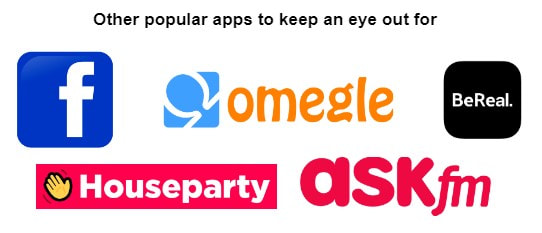|
Liz Greig. Provisional Psychologist  1.TikTok TikTok was created in 2016 as a social networking app designed to share user generated videos. Users can create and upload their own videos and browse and interact with other users' content. The TikTok ‘feed’ contains videos that are algorithmically selected based on its users past views and interest. Data from a 2022 survey conducted by PEW Research Centre showed that 67% of teens are actively using TikTok! Currently making TikTok the world's most popular social media platform. TikTok has been the subject of controversy recently as it has been critised for its use of algorithims that can push inapporiatye consent to users, including children and teens. TikTok can however be used for activism, education and other postivie purposes. Parents and guardians should be aware of the risks and benefits of the app, and monitor their teen's use of the app to ensure their safety and well-being.The following link (Parent’s Ultimate Guide to TikTok) is a useful resource to find out more about the functions of TikTok, how content is posted/ viewed and information about its safety features. https://www.commonsensemedia.org/articles/parents-ultimate-guide-to-tiktok  2. Instagram Instagram is a social media app created in 2010 as a way for users to post photos and videos, follow popular accounts and friends, and send private messages. Users can create and follow hashtags, join groups and communities, and share content through Instagram Stories and Reels. Instagram also offers features like Instagram Live, which allows users to broadcast live video to their followers, and Instagram Shopping, which enables users to shop directly from the app. The minimum age requirement to create an Instagram account is 13 years, however, like many social media apps there is no age verification process that eliminates people under 13 years from downloading and using the app. The type of content your teen might be seeing on Instagram varies depending on their personal preference and the accounts they follow. Some teens might be seeing content posted by friends, influences and/or meme accounts (accounts that focus on making funny, amusing content). Instagram does have a ‘sensitive content control’ setting, that allows users to choose how much potentially upsetting or offensive content they might see from accounts they do or don’t follow. Parents can also get updates about who their children are following, followed by and can set usage limits. It is important to note that Instagram accounts are made public by default, so if you would prefer your child's account to be private, they’re going to have to turn the privacy settings on manually. The following link (Parents’ ultimate guide to Instagram) is a helpful resource to find out more about how Instagram works and its potential risks and benefits. https://www.commonsensemedia.org/articles/parents-ultimate-guide-to-instagram  3. Snapchat Snapchat was created in 2011 as a way to share photos privately between two people. Now it can be used for a range of purposes, including sending videos, live video chatting, messaging, and sharing a ‘story’ that is broadcasted to all your friends. Other features include the ability to share your live location on a world map. Photos, videos, and messages sent through snapchat will disappear after they’re opened or after a default period of time (e.g., 24 hours). 13 years is the minimum age required to sign up for snapchat, however there is no age verification process currently in place when creating an account. Snapchat does have some parental controls through the privacy settings that allows parents to monitor their child’s snapchat activity. The following link (Is Snapchat Safe for Kids? A Parents’ Guide to Snapchat) can be used to find out more information about Snapchat, its features and how to turn on parental controls. https://www.avast.com/c-is-snapchat-safe-for-kids#:~:text=Age%2013%20is%20the%20minimum,to%20a%20global%20Spotlight%20video.  4. YouTube YouTube is a popular video-sharing platform that allows users to upload, watch, and share videos. It was founded in 2005 and is now one of the most popular websites in the world, with over 2 billion monthly active users. The platform offers a wide variety of content, including educational videos, music videos, tutorials, vlogs, and more. Users can subscribe to channels to keep up-to-date with their favorite content creators, and can also create their own channels to share their own videos. YouTube offers a number of features to enhance the user experience, including comments, likes, and dislikes, playlists, and personalized recommendations. Youtube has implemented some safety features to help protect teen users, including age restrictionds on certian vidoes and content, community guidelines (helps prohibit content that includes hate speech, harrassment or violence), comment moderation, and family link (parental controls).  5. Discord Discord is a communication app designed for gamers but has since expanded to other communities. The app was launched in 2015 and allows users to create and join servers, which are essentially chat rooms for groups of people with common interests. These servers can be public or private and can include text, voice, and video chat features. Discord also allows users to share files, links, and media within a server, making it a convenient platform for group projects and collaborations. Discord has implemented several safety features for teen users incluidng, age gating (minimum age of 13 years to create an account), content filtering, two factor authentication, and moderation guidelines. However, even with these safety features there are risks of teens encountering inappropriate content, cyberbullying, and other security issues. The following link (Parent’s Ultimate Guide to Discord) can be used to find out more information about Discord, its features and how the privacy settings work. https://www.commonsensemedia.org/articles/parents-ultimate-guide-to-discord It's important for parents to have open and honest conversations with their teens about online safety and responsible social media use. Parents should also be aware of the risks and benefits associated with their teens using certain apps. Common Sense Media (https://www.commonsensemedia.org/) is an organization that provides information, reviews and ratings for apps, movies, tv shows, books etc. so parents and caregivers can make informed decisions about the type of content their children are exposed to.
Comments are closed.
|
Categories
All
|
Hopscotch & HarmonyAt Hopscotch & Harmony Psychology, you can expect compassionate care and evidence-based guidance on your journey to wellness.
With clinics in Werribee and Belmont, as well as providing online counselling to clients who live throughout Australia, our dedicated team of psychologists and dietitians are committed to providing support to children, teenagers and adults. With a focus on understanding your unique needs, we offer tailored solutions to foster growth and resilience. Trust in our experience and dedication as we work together towards your well-being. Welcome to a place where healing begins and possibilities abound. |
Our services |
Contact usHopscotch & Harmony
Child, Teen and Adult Psychology Our Locations:
WERRIBEE: 1/167-179 Shaws Rd
BELMONT: 92 Roslyn Rd AUSTRALIA-WIDE: Online counselling |
Hopscotch and Harmony respectfully recognise the Aboriginal and Torres Strait Islander people as the first Peoples of the continent now called Australia.
We acknowledge the Bunurong and Wadawurrung people of the Kulin Nation, the traditional owners of the land on which we work, and pay our respects to their Elders, past, present and emerging.
© 2024 Hopscotch and Harmony Pty Ltd




 RSS Feed
RSS Feed
